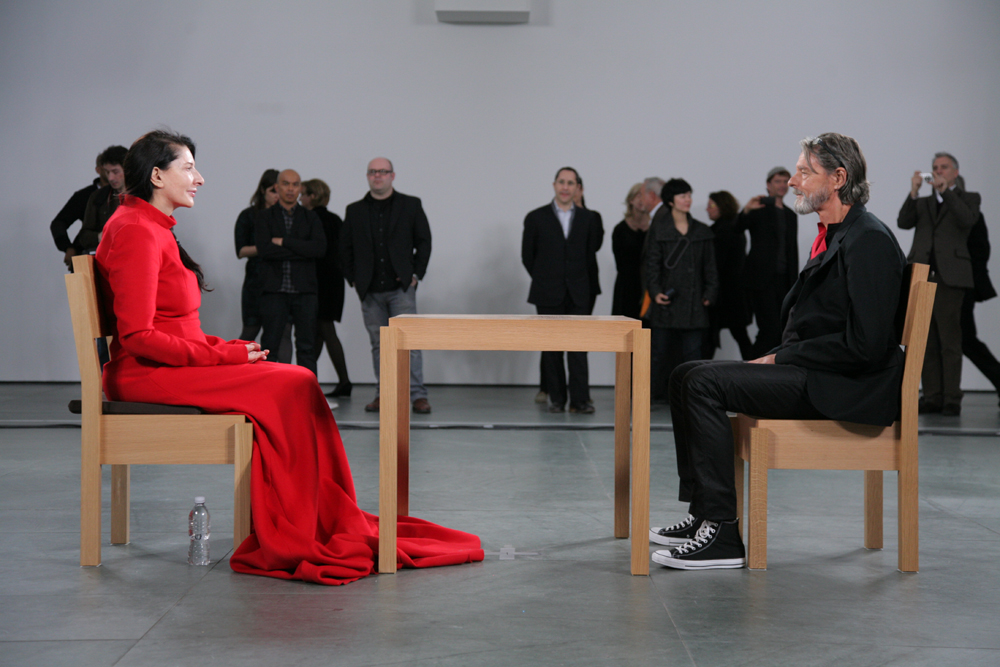The daughter of WW2 partisans, Marina Abramović makes art the way others make war: by putting her body on the frontline, and blurring the lines between creation and destruction. Her fans praise her for her strength and endurance, qualities more commonly cited in footsoldiers than performance artists, but which turn out to have been essential in this particular arena nevertheless: past shows have seen Abramović whipping herself, cutting away at her own flesh with a knife, and - when she'd finished self-harming - challenging gallery visitors to do what they like with her pliant form, using a table of props that included a loaded handgun. (You suspect some form of security measures must have been in place, but - even so - it's a miracle this happening went off without apparent injury, to Abramović or anybody else.)
Documentarist Matthew Akers joined Abramović in the run-up to her 2010 retrospective - titled, like the resulting film, The Artist is Present - at New York's Museum of Modern Art, and found her drilling her army of volunteers at a kind of conceptual art bootcamp, where they were encouraged to fast, stand blindfolded in a forest, and sort grains of rice, anything to heighten their focus when the confrontational moment - standing (often naked) in the gallery, in full view of the general public - came to pass. As the artist hands on the torch from her generation of performers to the next, a certain mellowing of the Abramović persona can be observed. Like a major-general, she now works from behind a desk: literally so, in the retrospective's centrepiece, which saw Abramović sitting at a table for the show's three-month duration while members of the public were ushered forward to sit across from her and observe a shared moment of silence. Consider it the conceptual world's own form of social networking: an artist connecting with her audience in the most astonishingly direct manner - the idea being that there is art (or some other form of lived experience) to be seen when you look into the whites of somebody's eyes. (And, to Abramović's eyes, the scenery would change by the minute, making this her equivalent to Antony Gormley's fourth-plinth project in Trafalgar Square, where the participants rotated every hour.)
Outside museum hours, Abramović exudes vitality and charisma: she claims to be 63, but doesn't look a day over 40. The film crew and her cast of young acolytes weren't the only ones drawn to her. In the shadows of the film lurks David Blaine, who arrives to pitch a stunt to Abramović - rejected, after minimal consideration - that sounds weirdly close to Borat's plan to kidnap Pamela Anderson; but there's also Abramović's ex, the performance artist Ulay, who's clearly still enormously fond of this woman. Akers was there for the magical moment when the latter, too, came to sit across from Abramović for a minute, capturing two long-time collaborators renewing their creative vows. Some visitors dress up for their encounter; before she's halted by security, one woman attempts to get undressed on the walk to the table, possibly in homage to Abramović's nipple-heavy, bush-baring early work. Some turn up more than once; some weep in her presence; others protest. The important thing is that this installation is broadly democratic - everyone who queues up gets their sixty seconds - and you're left wondering what an intense and unforgettable experience this must have been, to see this woman and be seen in turn, and for nothing else to matter.
In this superb, possibly definitive profile, Akers makes clear that exhibitions and the spaces they're held in are finally less important than that which this artist has always focused in on: faces and bodies. His most telling editorial choice may be an aside that has nothing strictly to do with Abramović's past or present - an episode in which one female MoMA patron realises she's been standing watching the artist for so long her foot's fallen asleep, and has to hobble over to the exit - which nevertheless illustrates the lengths people will go to watch the process. The film would be worth tracking down solely for the clips, highlighting four decades' worth of Abramović performances, which suggest there is something infinitely compelling and beautiful in watching the human body not just move - as hers does - but encountering obstacles, responding to stress, healing and enduring, as it does all the time beneath our clothes. This body of work will change your relationship to your own body, its perceived strengths and limitations: at the very least, it'll make you glad you don't have the compulsion to fast for two weeks or take a blade to your abdomen. After watching all that, you can forgive Abramović her desire to have a bit of a sit down.
Marina Abramović: The Artist is Present is available on DVD through Dogwoof.

No comments:
Post a Comment